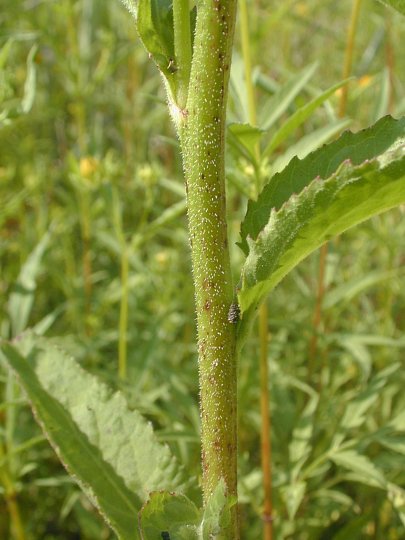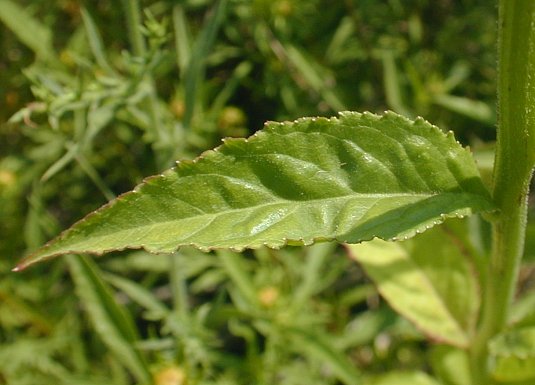Description: This herbaceous perennial plant is usually unbranched and 2–3½' tall. The central stem is light green, terete, and sparingly to densely hairy. The alternate leaves are up 6" long and 1½" across, but they are typically about one-half of this maximum size. The rough-textured leaves are lanceolate in shape and coarsely serrated along their margins; they have a tendency to curl upward along their central veins. The lower leaves have short petioles, while the upper ones are sessile. The undersides of leaves usually have fine hairs.

The central stem terminates in a spike-like raceme of showy red flowers (rarely white). This raceme is about ½–1½' long. The red corolla of each flower has a narrow tubular structure that is upright and terminates in grayish white reproductive organs; these organs nod downward. Beneath this are 2 narrow lateral lobes and a lower lip that is 3-lobed. The green calyx is deeply divided into 5 linear teeth that spread outward. The flowers are held at an upward angle in relation to the stem; they are about 1–1½" long and ¾–1" across. The blooming period occurs from late summer to early fall, lasting about 1–1½ months. There is no floral scent. The small seeds can be carried aloft by the wind. The root system consists of a taproot.

Cultivation: The preference is light shade to full sun, and wet to moist conditions. Cardinal Flower adapts to loam, sandy loam, or gravelly soil; the soil should contain some organic matter to retain moisture. This plant doesn't like to dry out and it has a reputation of being temperamental and short-lived. It is easier to establish this plant using transplants, as the seeds are quite small and the young seedlings are rather fragile.

Range & Habitat: The native Cardinal Flower has been observed in most counties of Illinois; it is occasional to locally common in southern Illinois, while in northern and central Illinois it tends to be less common or absent (see Distribution Map). Habitats include wet prairies, prairie swales, openings in floodplain and bottomland woodlands, soggy meadows along rivers and streams, gravelly seeps and springs, borders of ponds, edges of small marshes, and ditches. These habitats include both sandy and non-sandy areas. Cardinal Flower is often found in sunny areas near sources of water, or it is found in open woodland areas where moist depressions occur.

Faunal
Associations:
The nectar of the flowers attracts the Ruby-Throated Hummingbird and
various Swallowtail butterflies, including such species as Papilio
polyxenes asterias (Black Swallowtail), Papilio
troilus (Spicebush Swallowtail), and Battus philenor
(Pipevine Swallowtail). Sometimes the larger bumblebees will steal
nectar through slits in the tubular corolla. Halictid bees
sometimes gather pollen, but they are ineffective at pollination. The
larvae of a polyphagous fly, Metopomyza
scutellata, mine the leaves of Cardinal Flower. The
caterpillars of a moth, Enigmogramma
basigera (Pink-washed Looper Moth), also feed on the
leaves (Schweitzer & Roberts, 2007). The seeds
are too small to be of much interest to birds. Mammalian herbivores
usually don't consume this plant because of the toxic white latex in
the foliage. While it's a beautiful plant, the ecological value of
Cardinal Flower to wildlife is relatively low.
Photographic Location:
Most of the photographs were taken by the webmaster at Meadowbrook Park
in Urbana, Illinois; the plants were growing in a prairie swale. The
photograph of a Cardinal Plant with rare white flowers was taken by
Paul Showers (Copyright © 2013) in northeast Illinois.
Comments: The Cardinal Flower has striking red flowers that remind me of the Northern Cardinal and other exotic birds. Red is an unusual color in wildflowers – an attribute that it shares with Silene regia (Royal Catchfly) and Silene virginica (Fire Pink). Plants with red flowers typically attract hummingbirds; sometimes they also attract Swallowtail butterflies because their compound eyes, unlike those of bees, can detect the color red. The Cardinal Flower is often sold at garden centers, but such plants are often hybrids or special cultivars. One such hybrid is Lobelia X speciosa, which is a genetic cross of Lobelia cardinalis and Lobelia siphilitica (Great Blue Lobelia). This hybrid can naturalize in the wild, and resembles the former species to a greater extent than the latter. Its flowers are often magenta or deep rose, rather than brilliant red.
